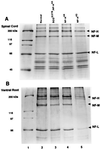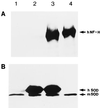Protective effect of neurofilament heavy gene overexpression in motor neuron disease induced by mutant superoxide dismutase
- PMID: 9689131
- PMCID: PMC21389
- DOI: 10.1073/pnas.95.16.9626
Protective effect of neurofilament heavy gene overexpression in motor neuron disease induced by mutant superoxide dismutase
Abstract
To investigate the role of neurofilaments in motor neuron disease caused by superoxide dismutase (SOD1) mutations, transgenic mice expressing a amyotrophic lateral sclerosis-linked SOD1 mutant (SOD1(G37R)) were mated with transgenic mice expressing human neurofilament heavy (NF-H) subunits. Unexpectedly, expression of human NF-H transgenes increased by up to 65%, the mean lifespan of SOD1(G37R) mice. Microscopic examination corroborated the protective effect of NF-H protein against SOD1 toxicity. Although massive neurodegeneration occurred in 1-yr-old mice expressing SOD1(G37R) alone, spinal root axons and motor neurons were remarkably spared in doubly SOD1(G37R);NF-H-transgenic littermates.
Figures





References
-
- Rosen D R, Siddique T, Patterson D, Figlewicz D A, Sapp P, Hentati A, Donaldson D, Goto J, O’Regan J P, Deng H X, et al. Nature (London) 1993;362:59–62. - PubMed
-
- Cudkowicz M E, McKenna-Yasek D, Sapp P E, Chin W, Geller B, Hayden D L, Schoenfeld D A, Hosler B A, Horvitz H R, Brown R H. Ann Neurol. 1997;41:210–221. - PubMed
-
- Fridovich I. Adv Enzymol Relat Areas Mol Biol. 1986;58:61–97. - PubMed
-
- Tu P H, Gurney M E, Julien J-P, Lee V M-Y, Trojanowski J Q. Lab Invest. 1997;76:441–456. - PubMed
-
- Cleveland D W, Bruijn L I, Wong P C, Marszalek J R, Vechio J D, Lee M K, Xu X S, Borchelt D R, Sisodia S S, Price D L. Neurology. 1996;47:S54–S61. - PubMed
Publication types
MeSH terms
Substances
Grants and funding
LinkOut - more resources
Full Text Sources
Other Literature Sources
Medical
Molecular Biology Databases
Miscellaneous

